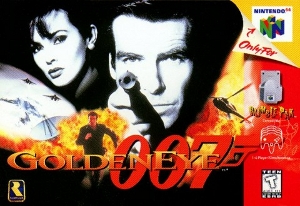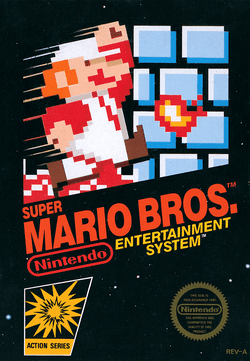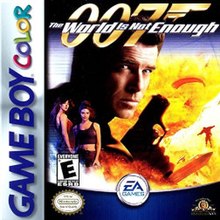
Super Mario World, known in Japan as Super Mario World: Super Mario Bros. 4, is a 1990 platform game developed by Nintendo EAD and published by Nintendo for the Super Nintendo Entertainment System (SNES). The player controls Mario on his quest to save Princess Peach and Dinosaur Land from the series' antagonist Bowser and the Koopalings. The gameplay is similar to that of earlier Super Mario games; players control Mario through a series of levels in which the goal is to reach the goalpost at the end. Super Mario World introduces Yoshi, a ridable dinosaur who can eat enemies.

Mario Tennis is a 2000 sports video game developed by Camelot Software Planning and published by Nintendo for the Nintendo 64. Following Mario's Tennis, it is the second game in the Mario Tennis series. The game is known for being the introduction of Luigi's arch-rival, Waluigi, and the re-introduction of Princess Daisy and Birdo.

Super Mario Land 2: 6 Golden Coins is a 1992 platform game developed and published by Nintendo for the Game Boy. It is the sequel to Super Mario Land. In Super Mario Land 2, the player assumes the role of the protagonist Mario, whose main objective is to reclaim his personal island, Mario Land, from the clutches of his greedy rival Wario. The gameplay builds and expands on that of its precursor with innovations carried over from Super Mario World.

Super Mario Land is a 1989 platform game developed and published by Nintendo as a launch game for its Game Boy handheld game console. It is the first Mario platform game to have been released for a handheld console. In gameplay similar to that of the 1985 Super Mario Bros., but resized for the smaller device's screen, the player advances Mario to the end of 12 levels by moving to the right and jumping across platforms to avoid enemies and pitfalls. Unlike the other Mario games, Super Mario Land is set in Sarasaland, a new environment depicted in line art, and Mario pursues the debuting Princess Daisy. The game has two Gradius-style shooter levels.

GoldenEye 007 is a 1997 first-person shooter video game developed by Rare and published by Nintendo for the Nintendo 64. Based on the 1995 James Bond film GoldenEye, the player controls the secret agent James Bond to prevent a criminal syndicate from using a satellite weapon. They navigate a series of levels to complete objectives, such as recovering or destroying objects, while shooting enemies. In a multiplayer mode, up to four players compete in several deathmatch scenarios via split-screen.

James Bond 007: Nightfire is a 2002 first-person shooter video game published by Electronic Arts for the GameCube, PlayStation 2, Xbox and Microsoft Windows, with additional versions released for the Game Boy Advance in 2003, and Mac OS X in 2004. The computer versions feature modifications to the storyline, different missions, and the removal of driving sections used in home console versions.

The World Is Not Enough is a first-person shooter video game developed by Eurocom and based on the 1999 James Bond film of the same name. It was published by Electronic Arts and released for the Nintendo 64 on October 17, 2000, shortly before the release of its PlayStation counterpart. The game features a single-player campaign in which players assume the role of secret agent James Bond as he fights to stop a terrorist from triggering a nuclear meltdown in the waters of Istanbul. It includes a split-screen multiplayer mode where up to four players can compete in different types of deathmatch and objective-based games.

Kirby Tilt 'n' Tumble is an action puzzle video game developed and published by Nintendo for the Game Boy Color handheld video game console. It was released in Japan on August 23, 2000, and in North America on April 9, 2001. Due to the cartridge having a built-in accelerometer, it has a unique shape, as well as a unique transparent pink color in reference to Kirby. The game received its first official re-release on the Nintendo Switch Online service on June 5, 2023.
The James Bond video game franchise is a series centering on Ian Fleming's fictional British MI6 agent, James Bond. Games of the series have been predominantly shooter games, with some games of other genres including role-playing and adventure games. Several games are based upon the James Bond films and developed and published by a variety of companies, The intellectual property is owned by Danjaq.

Kirby's Dream Course is a 1994 miniature golf video game developed by HAL Laboratory and Nintendo EAD and published by Nintendo for the Super Nintendo Entertainment System (SNES). A spin-off of the Kirby series and the first released for the SNES, players control the pink spherical character Kirby through a series of courses by launching him towards the goal hole at the end. Kirby can hit enemies to collect power-ups that grant him unique abilities, such as those that allow him to destroy certain obstacles or fly around the level.

Donkey Kong, also referred to as Donkey Kong '94, is a 1994 puzzle-platform game developed by Nintendo and Pax Softnica and published by Nintendo for the Game Boy. Donkey Kong is loosely based on the 1981 arcade game of the same name and its sequel Donkey Kong Jr.

Mega Man Xtreme is a 2000 video game developed by Capcom for the Game Boy Color handheld console. It is a spin-off title in the Mega Man X series of video games that originated on the Super Nintendo Entertainment System. Mega Man Xtreme takes place within the series timeline during the 22nd century, in which a group of "Maverick" androids called the "Shadow Hunters" hack into the world's "Mother Computer" system, destabilize all of the networks, and allow other Mavericks to cause rampant destruction all over the world. The heroic "Maverick Hunter" X is tasked with going into cyberspace to relive his past missions and put a stop to the group's plans.

Vertical Force is a 1995 vertically scrolling shooter video game developed and published for the Virtual Boy by Hudson Soft in Japan and by Nintendo in North America. The player controls a starship, the Ragnarok, that must destroy a malfunctioning supercomputer on a human colony planet before it wipes out all of mankind. Gameplay is similar to Hudson's Star Soldier series, featuring power-up items that increase the player's abilities and parallax scrolling. The player can move their ship farther into the background to avoid enemies and obstacles in the way.

Monster Max is a 1994 action-adventure puzzle video game developed by Rare and published by Titus France in Europe for the Game Boy. The player is the titular aspiring rock star, who, in an attempt to fight King Krond who bans all music, traverses nine floors of the Mega Hero Academy. Floors consist of diversely-designed rooms of puzzles to solve, the player having to figure out the order of actions to take.

Waterworld is a series of video games released for the Super Nintendo Entertainment System, Virtual Boy, MS-DOS, Microsoft Windows and Game Boy, based on the film of the same name, along with unpublished versions for the Mega Drive/Genesis, Sega Saturn, Atari Jaguar, 3DO and PlayStation. These games were produced by Ocean Software. The SNES and Game Boy games were released only in Europe in 1995 and the Virtual Boy game was released exclusively in North America in November 1995. It was released for PC in 1997. The game received widespread negative reviews and the version released for the Virtual Boy is generally considered to be the worst game of its 22 releases.

Buzz Lightyear of Star Command is a platform/shooter video game developed by Traveller's Tales and published by Disney Interactive and Activision in 2000. It is based on the animated series of the same name, a spin-off of the Toy Story franchise. It was released for Dreamcast, PlayStation, Microsoft Windows, and Game Boy Color. A version for the Nintendo 64 was planned but was later cancelled for unknown reasons.

Super Mario Bros. is a platform game developed and published in 1985 by Nintendo for the Famicom in Japan and for the Nintendo Entertainment System (NES) in North America. It is the successor to the 1983 arcade game Mario Bros. and the first game in the Super Mario series. Following a US test market release for the NES, it was converted to international arcades on the Nintendo VS. System in early 1986. The NES version received a wide release in North America that year and in PAL regions in 1987.

Turok 2: Seeds of Evil is an action-platform video game developed by Bit Managers and published by Acclaim Entertainment. It was released for the Game Boy Color handheld game console in 1998 alongside its Nintendo 64 counterpart. The game is backward compatible with the original Game Boy in monochrome mode. Although the game is set in the same world as its counterpart, it features a different storyline.

Turok: Rage Wars is an action video game developed by Bit Managers and published by Acclaim Entertainment for the Game Boy Color handheld console in 1999. Although the game is set in the same universe as its Nintendo 64 counterpart, it is a different game. The game received generally favorable reviews from critics.

The World Is Not Enough is a first-person shooter video game developed by Black Ops Entertainment and based on the 1999 James Bond film of the same name. It was published by Electronic Arts and released for the PlayStation on November 7, 2000, shortly after the release of its Nintendo 64 counterpart. The World Is Not Enough is the successor to Black Ops Entertainment's 1999 title Tomorrow Never Dies and uses an improved version of its engine. The game received mixed reviews from critics, who criticised its short length and lack of multiplayer mode.




















